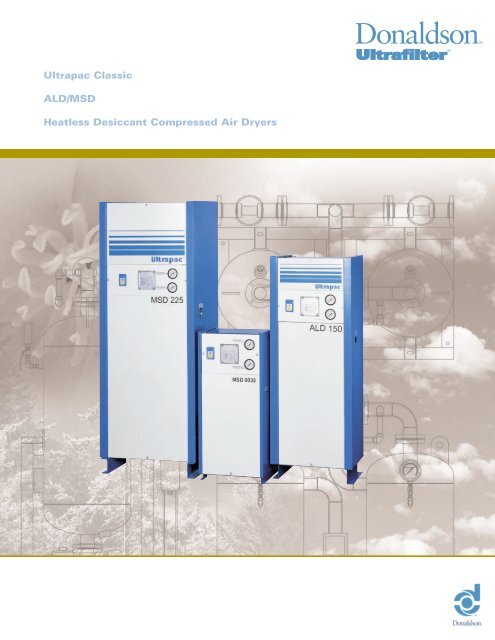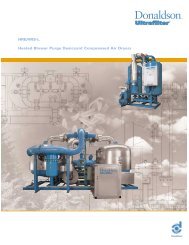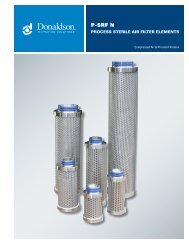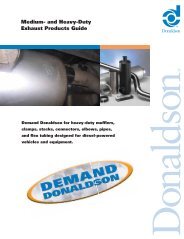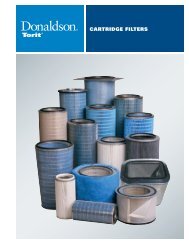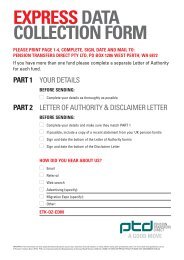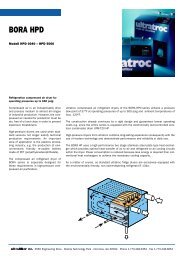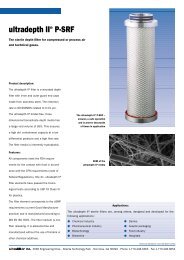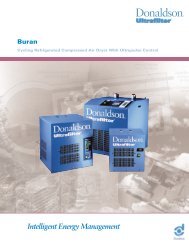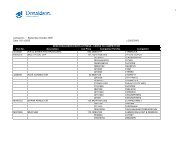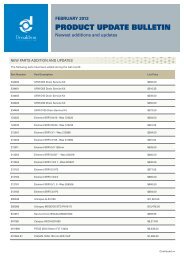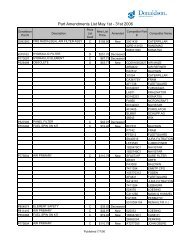Ultrapac Classic ALD/MSD Heatless Desiccant ... - odms.net.au
Ultrapac Classic ALD/MSD Heatless Desiccant ... - odms.net.au
Ultrapac Classic ALD/MSD Heatless Desiccant ... - odms.net.au
You also want an ePaper? Increase the reach of your titles
YUMPU automatically turns print PDFs into web optimized ePapers that Google loves.
<strong>Ultrapac</strong> <strong>Classic</strong><br />
<strong>ALD</strong>/<strong>MSD</strong><br />
<strong>Heatless</strong> <strong>Desiccant</strong> Compressed Air Dryers
History<br />
Ultrafilter International AG, whose world headquarters is in Haan,<br />
Germany, was established in 1972 as a trading company to buy and<br />
sell, into the German market, compressed air and gas purification<br />
equipment. In the 1980’s, Ultrafilter established itself as a prime<br />
manufacturer of compressed air and gas dryers and filters, backed by<br />
numerous innovative patents, and has since grown to be among the<br />
largest such manufacturers in the world. Our product lines include, but<br />
In 2002, Ultrafilter was acquired by Donaldson Company, Inc.,<br />
headquartered in Minneapolis, Minnesota. Donaldson is a leading<br />
worldwide provider of filtration systems and replacement parts. Since<br />
1915, Donaldson has perfected and leveraged its core strengths—<br />
innovative technology, strong customer relationships and broad<br />
geographic presence—to meet the diverse and changing needs<br />
of its customers.<br />
are not limited to: air, gas and liquid filters for both process and<br />
industrial applications; refrigerated, membrane and regenerative<br />
desiccant compressed air and gas dryers; breathing air systems;<br />
condensate management systems; and process water chillers.<br />
The Need for Clean Dry Air<br />
The Problem<br />
Corrosion, erosion, product defects, line freeze-ups<br />
The Result;<br />
Energy savings, increased productivity, longer lasting tools, and<br />
reduced system maintenance.<br />
The C<strong>au</strong>se<br />
Solids, liquids, vapors, gases<br />
Any contaminants present in the atmosphere surrounding an air<br />
compressor will be entrained and concentrated in the process air as it<br />
The Solution<br />
High quality and energy efficient air and gas purification systems<br />
enters the compressor. These contaminants can be in the form of<br />
liquids (e.g. water and oil), vapors (e.g. hydrocarbons), gases (e.g.<br />
carbon dioxide, hydrogen chloride and sulfur dioxide) and solids (e.g.<br />
sand, dust and soot). If not removed, such contaminants can lead to<br />
serious damage of process equipment and/or degradation of the final<br />
product itself through corrosion, erosion, freeze-ups, biological growth<br />
and product spoilage from contact with contaminated air.<br />
Donaldson Ultrafilter products are designed to address these problems<br />
efficiently and economically.
<strong>Ultrapac</strong> <strong>Classic</strong> <strong>ALD</strong>/<strong>MSD</strong> heatless desiccant compressed air dryers<br />
benefit from decades of design and fabrication experience by<br />
Ultrafilter. Our dryers are designed to consistently provide quality air<br />
with high energy efficiency in a flow range from 3 to 5,000 scfm.<br />
Operation is fully <strong>au</strong>tomatic with a guaranteed outlet dew point of<br />
-40˚ F or -100˚ F.<br />
Pre-and afterfilters<br />
Panel-mounted<br />
controls and g<strong>au</strong>ges<br />
<strong>ALD</strong><br />
-40˚ F pdp<br />
<strong>MSD</strong><br />
-100˚ F pdp<br />
Panel-mounted zero-loss<br />
drain control and test<br />
Guaranteed<br />
outlet dew point<br />
A number of unique features set <strong>Ultrapac</strong> <strong>Classic</strong> dryers apart from<br />
the competition. They include, but are not limited to:<br />
• Each dryer in the 3-600 scfm flow range is enclosed in a<br />
protective cabi<strong>net</strong> with easy-to-remove panels.<br />
Zero-loss<br />
condensate<br />
drain<br />
• All <strong>Ultrapac</strong> <strong>Classic</strong> dryers are supplied with preinstalled<br />
Ultrafilter industrial prefilters and afterfilters. Each is equipped<br />
with an Econometer differential pressure g<strong>au</strong>ge, and the<br />
coalescing prefilter is equipped with the Ultramat zero-loss<br />
condensate drain.<br />
• Filters are oversized with large surface area to keep system<br />
pressure drop to a minimum—among the lowest in the industry.<br />
• The compact design of <strong>Ultrapac</strong> dryers takes up a minimum of<br />
floor space, having one of the smallest footprints in the industry.<br />
• Ideally located inlet and outlet connections allow<br />
for easy installation.<br />
• Unique dual-purge lines—one fixed, one adjustable—allow<br />
the operator to fine-tune purge air consumption to maximize<br />
energy efficiency.<br />
Protective attractive<br />
cabi<strong>net</strong><br />
Extremely small<br />
footprint<br />
Ideally-located<br />
inlet and outlet<br />
connections for<br />
easy installation<br />
• Panel-mounted controller, vessel pressure g<strong>au</strong>ges and zero-loss<br />
drain control for ease of operation and system monitoring.<br />
• <strong>Ultrapac</strong>’s unique intermittent operation connects the dryer<br />
directly to the compressor so that each operates in sync with the<br />
other—the dryer only cycles when necessary, saving energy. Even<br />
more energy savings can be achieved with use of the optional<br />
Ultraconomy dew point dependent control.<br />
• Numerous options are available to customize the <strong>Ultrapac</strong> <strong>Classic</strong><br />
dryer to your needs.
<strong>Ultrapac</strong> Process Flow<br />
1• Compressed air saturated with moisture and containing concentrated particulates and other contaminants enters the coalescing prefilter<br />
which removes liquid water and oil, and solid particles.<br />
2• Prefiltered compressed air then enters the bottom of the on-line drying vessel, passing through a simple, pressure controlled, shuttle valve.<br />
3• As the air flows upward through the bed, water vapor is removed from the air as water molecules adsorb on to the surface of the desiccant<br />
beads. Energy, called the heat of adsorption, is released and stored in the bed to be used for regeneration in a later step.<br />
4• Dry compressed air at -40˚ F or –100˚ F pdp exits the top of the on-line drying vessel.<br />
5• The dried air then passes through a particulate afterfilter before entering the plant air system.<br />
6• A small volume of dried compressed purge air is redirected from the outlet of the on-line vessel to the top of the off-line, regenerating vessel.<br />
7• The purge air is reduced to atmospheric pressure and flows downward through the off-line vessel. The low dew point of the expanded purge<br />
air, combined with the heat of adsorption stored in the bed, c<strong>au</strong>ses the water molecules to desorb off of the surface of the desiccant beads,<br />
regenerating the bed.<br />
8• Wet purge air exits through the exh<strong>au</strong>st muffler.<br />
9• At the end of the drying cycle, the on-line bed depressurizes downward through the exh<strong>au</strong>st muffler, after which it goes off-line<br />
for regeneration.<br />
4<br />
6<br />
7<br />
1<br />
5<br />
3<br />
2<br />
9<br />
8
Ultraconomy Energy Management System<br />
Although sized for a specific flow requirement, compressed air systems do not necessarily operate at full capacity, 24 hours a day.<br />
However, a standard heatless desiccant dryer will consume approximately 15% of its design capacity for regeneration regardless of<br />
actual utilization rate. When a heatless dryer routinely operates at less than its full design capacity, excess energy is consumed in the<br />
form of wasted purge air. With the addition of the optional Ultraconomy energy management system, you can eliminate this excess<br />
energy consumption and lower your operating costs.<br />
During normal operation, <strong>Ultrapac</strong> dryers operate on a fixed cycle divided into drying, regeneration and repressurization stages. No<br />
adjustment to this cycle is made for changes in dryer inlet conditions such as flow rate, temperature or relative humidity, all of which<br />
affect the load on the dryer. When operating in Ultraconomy mode, the dew point of the process air is monitored at the dryer outlet to<br />
determine whether or not regeneration should be initiated. The drying stage will be extended until the dew point rises above a given set<br />
point or for a maximum of 35 minutes. This maximum drying time is set to assure that the desiccant bed does not become saturated<br />
with moisture, keeping the process air dew point at –40˚F or lower throughout the cycle.<br />
AG Industrial Prefilters and Afterfilters<br />
All <strong>Ultrapac</strong> <strong>Classic</strong> dryers are equipped with our top-of-the-line AG prefilters and<br />
afterfilters. These filters include all of the features required to make them the most<br />
efficient and cost effective filters for your compressed air system. Their three-part<br />
aluminum housing design allows for easy disassembly and element change-out.<br />
Low pressure drop is achieved through optimal flow-path design. The tapered bowl<br />
and non-turbulent lower filter zone assure that no condensate gets<br />
re-entrained in the air stream. Our Econometer differential pressure g<strong>au</strong>ge notifies<br />
maintenance personnel of the point at which to change the filter element. For<br />
coalescing prefilters, the Ultramat zeroloss<br />
drain valve assures that no<br />
compressed air is lost when liquid<br />
condensate is drained.
<strong>Ultrapac</strong> <strong>Classic</strong> <strong>ALD</strong>/<strong>MSD</strong> <strong>Heatless</strong> <strong>Desiccant</strong> Compressed<br />
Air Dryers<br />
<strong>Ultrapac</strong> <strong>Classic</strong> dryers are designed to provide high drying efficiency in a wide range of flow capacities. Two<br />
series of models are available to produce outlet dew points of -40˚ F or -100˚ F. Their compact design, including<br />
preinstalled prefilters and afterfilters, allows for quick and easy installation with a very small footprint.<br />
Key Features and Benefits<br />
• Guaranteed dew point performance (-40˚ F or -100˚ F)<br />
• Models 0003-60 to 0600-60 in full enclosure for quiet, clean operation<br />
• All models equipped with preinstalled filters for reduced installation costs<br />
• Coalescing prefilter equipped with Ultramat zero-loss drain valve<br />
• Low pressure drop for energy savings<br />
• Small footprint saves valuable floor space<br />
• Ideally-located connections for easy installation<br />
• Adjustable purge for optimum performance<br />
• NEMA 4 protection is standard<br />
Available Options (partial list)<br />
• Ultraconomy energy management system<br />
• Dual prefilter and afterfilter systems<br />
• 3 to 9 valve bypass systems<br />
• Dew point monitor and alarm<br />
• Pneumatic control<br />
• PLC controller<br />
• Silicon-free components<br />
• Non-standard power supply<br />
• Stainless steel instrument air tubing<br />
• Low-ambient package<br />
• Start-up device<br />
• Failure-to-switch alarm
Ultradepth ® MF Coalescing<br />
Prefilter Elements<br />
Ultrapoly ® PE Particulate<br />
Afterfilter Elements<br />
The unique design of Ultradepth MF filter elements<br />
creates a two-stage filtration process within one<br />
element. The retention rate of 0.01 µm particles in<br />
our MF element is a remarkable 99.99998%. This is<br />
made possible by the use of our patented Ultrair ®<br />
Ultrapoly PE particulate filter elements are made with<br />
aluminum end-caps, double o-ring seals and<br />
sintered polyethylene media for effective filtration<br />
down to 5 µm. PE elements offer the additional<br />
advantage of being fully regenerable.<br />
binder-free borosilicate glass fiber media. This<br />
media also allows for very low pressure drop, which<br />
means that you get the highest efficiency at the<br />
lowest energy cost.<br />
Capacity Correction Factors — Inlet Air Pressure<br />
Replacement Filter Elements<br />
Operating Pressure (psig) 60 75 90 100 115 130 150 160 175 190 200 225<br />
Correction Factor 0.63 0.75 0.88 1 1.12 1.25 1.38 1.5 1.63 1.75 1.88 2<br />
Prefilters<br />
Dryer Model<br />
Element<br />
0003-60 to 0010-60 MF0305<br />
Capacity Correction Factors — Inlet Air Temperature<br />
Operating Temperature (˚F) 68 77 86 100 104 115 125<br />
Correction Factor <strong>ALD</strong> 1.2 1.2 1.1 1 N/A N/A N/A<br />
Correction Factor <strong>MSD</strong> 1 1 1 1 0.8 0.7 0.5<br />
0015-60 to 0020-60 MF0410<br />
0030-60 to 0050-60 MF0520<br />
0060-60 to 0085-60 MF0525<br />
0125-60 to 0200-60 MF0730<br />
0300-60 to 0400-60 MF1030<br />
0500-60 MF1530<br />
0600-60 MF2030<br />
Replacement Filter Elements<br />
Operating Parameters<br />
Operating Pressure 40 psig minimum; 225 psig max. Up to 0600-60; 150 psig for 0800-60 and larger<br />
Operating Temperature 40˚ F minimum; 125˚ F maximum.<br />
Ambient Temperature 38˚ F minimum; 125˚ F maximum.<br />
Pressure Dew Point <strong>ALD</strong>: -40˚ F, <strong>MSD</strong>: -100˚ F<br />
Purge Losses<br />
<strong>ALD</strong>: 15%, <strong>MSD</strong>: 20% of rated capacity<br />
Medium<br />
Compressed air or nitrogen<br />
Noise Level<br />
80 dB (A)<br />
Vessel Code ASME, Models 0060-60 to 5000-60<br />
Afterfilters<br />
Dryer Model<br />
Element<br />
0003-60 to 0010-60 PE0305<br />
0015-60 to 0020-60 PE0410<br />
0030-60 to 0050-60 PE0520<br />
0060-60 to 0085-60 PE0525<br />
0125-60 to 0200-60 PE0730<br />
To choose a dryer based on a given flow at<br />
non-standard operating conditions, divide<br />
the given capacity by the appropriate<br />
correction factor(s).<br />
Example<br />
Given Flow: 250 scfm<br />
Actual Operating Conditions:<br />
150 psig working pressure (cf 1.38)<br />
86˚F inlet temperature (cf 1.1)<br />
Adjusted Flow = 250 scfm ÷ 1.38 ÷ 1.1 =<br />
165 scfm<br />
Selected Dryer Model: <strong>ALD</strong>0175-60<br />
To calculate the capacity of a given dryer based<br />
on non-standard operating conditions, multiply<br />
the standard capacity by the appropriate<br />
correction factor(s).<br />
Example<br />
Dryer Model: <strong>ALD</strong>0125-60<br />
Standard Capacity: 125 scfm<br />
Actual Operating Conditions:<br />
130 psig working pressure (cf 1.25)<br />
86˚ F inlet temperature (cf 1.1)<br />
Adjusted Capacity = 125 scfm x 1.25 x 1.1 =<br />
172 scfm<br />
0300-60 to 0400-60 PE1030<br />
0500-60 PE1530<br />
0600-60 PE2030
Model<br />
Number<br />
Capacity 1<br />
(scfm)<br />
Connections<br />
(in.)<br />
Dimensions (in.)<br />
Height Width Depth<br />
Weight<br />
(lb)<br />
0003-60 3 3/8 (FNPT) 28 19 10 59<br />
0005-60 5 3/8 (FNPT) 28 19 10 73<br />
0010-60 10 3/8 (FNPT) 42 19 10 90<br />
0015-60 15 1/2 (FNPT) 42 19 10 97<br />
0020-60 20 1/2 (FNPT) 42 19 10 106<br />
0030-60 30 3/4 (FNPT) 63 26 12 235<br />
0050-60 50 3/4 (FNPT) 63 26 12 308<br />
0060-60 60 1 (FNPT) 63 26 12 372<br />
0085-60 85 1 (FNPT) 78 30 18 440<br />
0100-60 100 1 (FNPT) 78 30 18 561<br />
0125-60 125 1 1/2 (FNPT) 78 30 18 609<br />
0175-60 175 1 1/2 (FNPT) 78 30 18 706<br />
0200-60 200 1 1/2 (FNPT) 86 37 21 876<br />
0300-60 300 2 (FNPT) 86 4 21 948<br />
0400-60 400 2 (FNPT) 86 37 21 1113<br />
0500-60 500 2 (FNPT) 93 43 26 1309<br />
0600-60 600 2 1/2 (FNPT) 93 43 26 1487<br />
0800-60 800 3 (ANSI Flange) 101 59 37 1914<br />
1000-60 1000 3 (ANSI Flange) 93 67 41 2200<br />
1200-60 1200 4 (ANSI Flange) 102 71 45 2431<br />
1400-60 1400 4 (ANSI Flange) 103 75 51 2970<br />
1600-60 1600 4 (ANSI Flange) 106 79 53 3366<br />
2000-60 2000 4 (ANSI Flange) 106 87 59 3784<br />
2400-60 2400 6 (ANSI Flange) 117 94 64 5610<br />
3000-60 3000 6 (ANSI Flange) 119 102 68 6490<br />
3500-60 3500 6 (ANSI Flange) 121 110 71 7700<br />
4000-60 4000 6 (ANSI Flange) 121 118 75 8503<br />
5000-60 5000 8 (ANSI Flange) 129 134 90 12804<br />
1<br />
Capacity based on -40˚ F pdp (<strong>ALD</strong>), -100˚ F pdp (<strong>MSD</strong>), 100 psig inlet pressure, 100˚ F inlet temperature and 100˚ F ambient in accordance<br />
with CAGI ADF200.<br />
<strong>ALD</strong>/<strong>MSD</strong> 0003-60 to 0600-60 <strong>ALD</strong>/<strong>MSD</strong> 0800-60 to 5000-60<br />
Donaldson Company, Inc.<br />
Ultrafilter<br />
3560 Engineering Drive<br />
Norcross, GA 30092<br />
©2003 Bulletin No. UFSB0103<br />
Toll free: 800.543.3634<br />
Telephone: 770.448.3363<br />
Telefax: 770.448.3854<br />
E-mail: info@ultrafilter-us.com<br />
Web: www.ultrafilter-us.com


